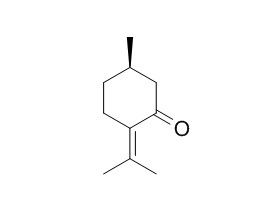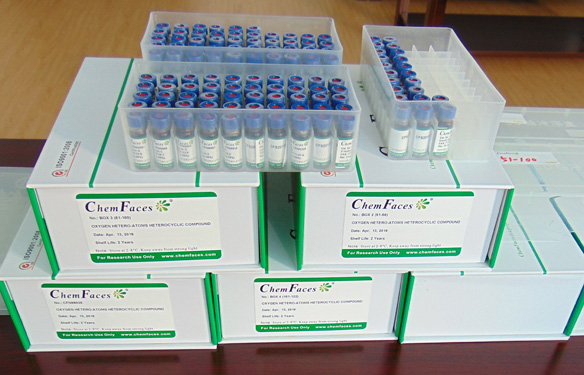Pulegone
Pulegone is a fragrance and flavour ingredient. Pulegone has cytotoxicity followed by regenerative cell proliferation is the MOA for Pulegone-induced urothelial tumors in female rats. Pulegone induces a verapamil-sensitive psychostimulant effect that appears to independ on the opening of L-type calcium channels.
Inquire / Order:
manager@chemfaces.com
Technical Inquiries:
service@chemfaces.com
Tel:
+86-27-84237783
Fax:
+86-27-84254680
Address:
1 Building, No. 83, CheCheng Rd., Wuhan Economic and Technological Development Zone, Wuhan, Hubei 430056, PRC
Providing storage is as stated on the product vial and the vial is kept tightly sealed, the product can be stored for up to
24 months(2-8C).
Wherever possible, you should prepare and use solutions on the same day. However, if you need to make up stock solutions in advance, we recommend that you store the solution as aliquots in tightly sealed vials at -20C. Generally, these will be useable for up to two weeks. Before use, and prior to opening the vial we recommend that you allow your product to equilibrate to room temperature for at least 1 hour.
Need more advice on solubility, usage and handling? Please email to: service@chemfaces.com
The packaging of the product may have turned upside down during transportation, resulting in the natural compounds adhering to the neck or cap of the vial. take the vial out of its packaging and gently shake to let the compounds fall to the bottom of the vial. for liquid products, centrifuge at 200-500 RPM to gather the liquid at the bottom of the vial. try to avoid loss or contamination during handling.
JEJU National University2022, 10478.
J Integr Plant Biol.2023, 13564.
Cosmetics2025, 12(3), 108
Heliyon.2023, 9(11):e21944.
Histol Histopathol.2022, 18518.
Research J. Pharm. and Tech.2020, 13(7):3059-3064.
Evid Based Complement Alternat Med.2016, 2016:4357656
Processes2022, 10(10), 2008.
Plants (Basel).2024, 13(6):868.
Environ Toxicol.2023, 23929.
Related and Featured Products
Biol Pharm Bull. 2014;37(5):771-8.
The aversive, anxiolytic-like, and verapamil-sensitive psychostimulant effects of pulegone.[Pubmed:
24790000]
METHODS AND RESULTS:
We investigated the psychostimulant, rewarding, and anxiolytic-like effects of Pulegone. Possible interactions between Pulegone and menthol concerning their psychostimulant effect were also analyzed. General mouse activity after Pulegone treatment, and the interacitons between Pulegone and menthol, were determined in the open field. The anxiolytic-like activity, motor coordination and strength force were evaluated using the elevated plus maze (EPM), rotarod test and grasping test, respectively. The motivational properties of Pulegone were evaluated by pairing the drug effects on the mice with the least preferred compartment (previously determined) of a conditioned place preference (CPP) apparatus. Pulegone increased mouse locomotor activity and immobilization time. Verapamil, but not diltiazem, haloperidol or picrotoxin, decreased the psychostimulation induced by Pulegone. Pulegone also decreased grooming and rearing behaviors and caused motor incoordination and weakness at high doses. Pulegone increased the time spent by mice in the open arms of the EPM, and flumazenil pre-treatment did not alter this effect. Pulegone either produced no CPP or induced conditioned place aversion. The changes in mouse ambulatory activity caused by the association of Pulegone with menthol were either lower than those predicted by the theoretical curve or not different from the predicted values.
CONCLUSIONS:
Therefore, Pulegone induces a verapamil-sensitive psychostimulant effect that appears to independ on the opening of L-type calcium channels. Pulegone has negative reinforcing properties and seems to possess anxiolytic-like actions unrelated to the benzodiazepine site of the γ-aminobutyric acid type A (GABAA) receptor. Finally, Pulegone might act in an addictive or synergic way with menthol.
Biochem Pharmacol . 2018 May;151:89-95.
Involvement of nociceptive transient receptor potential channels in repellent action of pulegone[Pubmed:
29501584]
Abstract
Pulegone, one of avian repellents, is used to prevent the economic loss caused by birds. Chemical repellents often evoke unpleasant sensations and sensory irritation resulting in avoidance under some circumstances. It is recognized that some TRP channels expressing sensory neurons are related to nociception. Here we determined the molecular mechanisms of the repellent action of Pulegone using isolated chicken sensory neurons and heterologous expression system. Pulegone increased the intracellular Ca2+ concentration ([Ca2+]i) in chicken sensory neurons. There were two types of neurons exhibiting different sensitivity to Pulegone. One was responded to it at low concentrations and the other at high concentrations. Pharmacological analyses revealed that the former was predominantly mediated by TRP melastatin 8 (TRPM8), and the latter by both TRP ankyrin 1 (TRPA1) and TRPM8. An activation of both channels by Pulegone was also determined using heterologously expression system. At high concentrations, Pulegone suppressed chicken TRPM8 but not chicken TRPA1. The intraplantar injection of Pulegone in chicks caused pain-related behaviors that were attenuated by TRPA1 antagonist. These results indicate that Pulegone stimulates both TRPM8 and TRPA1 channel in chicken sensory neurons and suppresses the former but not the latter at high concentrations. Together, these data suggest that the molecular target for the repellent action of Pulegone in avian species is nociceptive TRPA1.
Keywords: AITC (PubChem CID: 5971); AMTB (PubChem CID: 16095383); HC-030031 (PubChem CID: 1150897); Intracellular Ca(2+) increase; Ion channels; Pulegone (PubChem CID: 442495); Repellent; Sensory neuron; TRP channel.
Toxicol Sci. 2012 Jul;128(1):1-8.
Mode of action of pulegone on the urinary bladder of F344 rats.[Pubmed:
22499580]
Essential oils from mint plants, including peppermint and pennyroyal oils, are used at low levels as flavoring agents in various foods and beverages. Pulegone is a component of these oils.
METHODS AND RESULTS:
In a 2-year bioassay, oral administration of Pulegone slightly increased the urothelial tumor incidence in female rats. We hypothesized that its mode of action (MOA) involved urothelial cytotoxicity and increased cell proliferation, ultimately leading to tumors. Pulegone was administered by gavage at 0, 75, or 150 mg/kg body weight to female rats for 4 and 6 weeks. Fresh void urine and 18-h urine were collected for crystal and metabolite analyses. Urinary bladders were evaluated by light microscopy and scanning electron microscopy (SEM) and bromodeoxyuridine (BrdU) labeling index. Pulegone and its metabolites, piperitenone, piperitone, menthofuran, and menthone, were tested for cytotoxicity in rat (MYP3) and human (1T1) urothelial cells by the 3-(4,5-dimethythiazol-2-yl)-2,5-diphenyl tetrazolium bromide assay. No abnormal urinary crystals were observed by light microscopy. Urine samples (18-h) showed the presence of Pulegone, piperitone, piperitenone, and menthofuran in both treated groups. By SEM, bladders from treated rats showed superficial necrosis and exfoliation. There was a significant increase in the BrdU labeling index in the high-dose group. In vitro studies indicated that Pulegone and its metabolites, especially piperitenone, are excreted and concentrated in the urine at cytotoxic levels when Pulegone is administered at high doses to female rats.
CONCLUSIONS:
The present study supports the hypothesis that cytotoxicity followed by regenerative cell proliferation is the MOA for Pulegone-induced urothelial tumors in female rats.



